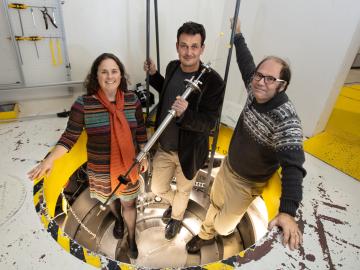
Filter News
Area of Research
- (-) Fusion Energy (2)
- (-) National Security (24)
- (-) Neutron Science (44)
- Advanced Manufacturing (6)
- Biological Systems (1)
- Biology and Environment (39)
- Computational Biology (2)
- Computational Engineering (2)
- Computer Science (9)
- Electricity and Smart Grid (3)
- Energy Science (134)
- Functional Materials for Energy (1)
- Fusion and Fission (10)
- Isotope Development and Production (1)
- Isotopes (8)
- Materials (109)
- Materials Characterization (1)
- Materials for Computing (18)
- Materials Under Extremes (1)
- Nuclear Science and Technology (5)
- Quantum information Science (1)
- Sensors and Controls (1)
- Supercomputing (71)
- Transportation Systems (2)
News Topics
- (-) Artificial Intelligence (18)
- (-) Biomedical (16)
- (-) Grid (6)
- (-) Materials Science (26)
- (-) Transportation (7)
- 3-D Printing/Advanced Manufacturing (9)
- Advanced Reactors (9)
- Big Data (8)
- Bioenergy (10)
- Biology (11)
- Biotechnology (2)
- Buildings (1)
- Chemical Sciences (5)
- Clean Water (2)
- Composites (1)
- Computer Science (33)
- Coronavirus (12)
- Cybersecurity (19)
- Energy Storage (8)
- Environment (13)
- Exascale Computing (1)
- Fossil Energy (1)
- Frontier (3)
- Fusion (17)
- High-Performance Computing (6)
- Hydropower (1)
- Machine Learning (15)
- Materials (17)
- Mathematics (1)
- Microscopy (3)
- Nanotechnology (11)
- National Security (35)
- Neutron Science (120)
- Nuclear Energy (17)
- Partnerships (5)
- Physics (10)
- Polymers (1)
- Quantum Computing (1)
- Quantum Science (8)
- Security (12)
- Simulation (1)
- Space Exploration (3)
- Summit (8)
Media Contacts

Biological membranes, such as the “walls” of most types of living cells, primarily consist of a double layer of lipids, or “lipid bilayer,” that forms the structure, and a variety of embedded and attached proteins with highly specialized functions, including proteins that rapidly and selectively transport ions and molecules in and out of the cell.

An international team of researchers has discovered the hydrogen atoms in a metal hydride material are much more tightly spaced than had been predicted for decades — a feature that could possibly facilitate superconductivity at or near room temperature and pressure.

A typhoon strikes an island in the Pacific Ocean, downing power lines and cell towers. An earthquake hits a remote mountainous region, destroying structures and leaving no communication infrastructure behind.

To better determine the potential energy cost savings among connected homes, researchers at Oak Ridge National Laboratory developed a computer simulation to more accurately compare energy use on similar weather days.

Scientists at the U.S. Department of Energy’s Brookhaven National Laboratory have new experimental evidence and a predictive theory that solves a long-standing materials science mystery: why certain crystalline materials shrink when heated.

IDEMIA Identity & Security USA has licensed an advanced optical array developed at Oak Ridge National Laboratory. The portable technology can be used to help identify individuals in challenging outdoor conditions.

Using additive manufacturing, scientists experimenting with tungsten at Oak Ridge National Laboratory hope to unlock new potential of the high-performance heat-transferring material used to protect components from the plasma inside a fusion reactor. Fusion requires hydrogen isotopes to reach millions of degrees.

Scientists have discovered a way to alter heat transport in thermoelectric materials, a finding that may ultimately improve energy efficiency as the materials

OAK RIDGE, Tenn., March 20, 2019—Direct observations of the structure and catalytic mechanism of a prototypical kinase enzyme—protein kinase A or PKA—will provide researchers and drug developers with significantly enhanced abilities to understand and treat fatal diseases and neurological disorders such as cancer, diabetes, and cystic fibrosis.



